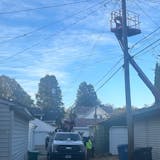A group of public officials on a chilly Tuesday made a heated call for state spending on Minnesota's transportation network.
Gathered on a highway bridge overlooking the interchange of I-35W and I-494, local and state leaders made their pitch in support of Gov. Mark Dayton's 10-year, $6 billion spending plan. The site was chosen because the 35W/494 interchange recently was named one of the nation's 20 worst highway bottlenecks by the Federal Highway Administration.
"Hundreds of thousands of people drive through this interchange every day on their way to work or school, and back again," said Lt. Gov. Tina Smith. "Nearly all of those Minnesotans needlessly waste hours every week stuck inching through bumper-to-bumper traffic. The time for admiring this problem is over. It is time to roll up our sleeves and do something about it."
Tuesday's remarks added detail to the transportation funding proposed by Dayton revealed last week. The plan would repair, replace or expand more than 2,200 miles of state roads and 330 bridges over the next decade, but individual projects were not identified. To pay for the projects, Dayton seeks a 6.5 percent gross receipts tax on gasoline at the wholesale level, an increase in license tab fees and $2 billion in trunk highway bonds.
Plan challenged at Capitol
While his plan enjoys wide support among DFLers, Republican lawmakers challenge Dayton's take on the scope of the problem and the funding solution. House Republicans in January proposed tapping the state's projected budget surplus and shaving spending at the Minnesota Department of Transportation to fund $750 million in repairs over the next four years. They have opposed any tax hike.
Smith and Charlie Zelle, transportation commissioner, joined more than 25 elected officials and business leaders, mostly from southwest suburbs, to put the pressure on Tuesday.
"The sooner we can get started on this project, the better," Zelle said. "If we do nothing, traffic will keep getting worse and the costs of rebuilding this interchange will only grow higher. A half-century of waiting has produced one of the worst traffic jams in the nation."
Richfield Mayor Debbie Goettel endorsed the wholesale gas tax. "We need a long-term solution, and I think this time the gas tax is the best way to address it," she said.


